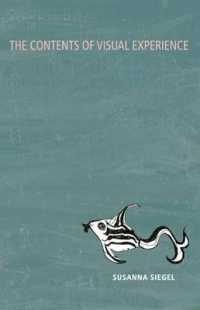Full Description
ALERTcourse syllabus to ensure that you select the correct ISBN. Several versions of Pearson's MyLab & Mastering products exist for each title, including customized versions for individual schools, and registrations are not transferable. In addition, you may need a CourseID, provided by your instructor, to register for and use Pearson's MyLab & Mastering products.PackagesAccess codes for Pearson's MyLab & Mastering products may not be included when purchasing or renting from companies other than Pearson; check with the seller before completing your purchase.Used or rental booksIf you rent or purchase a used book with an access code, the access code may have been redeemed previously and you may have to purchase a new access code.Access codesAccess codes that are purchased from sellers other than Pearson carry a higher risk of being either the wrong ISBN or a previously redeemed code. Check with the seller prior to purchase.--This rhetoric/anthology instructs college students in how to read academic texts with understanding and how to use them as sources for papers in a variety of disciplines. In Writing in the Disciplines, Mary Kennedy and William Kennedy emphasize academic writing as ongoing conversations in multiple genres, and do so in the context of WPA Outcomes. The rhetoric chapters teach critical reading, paraphrasing, summarizing, quoting, writing process, synthesizing, analyzing, researching, and developing arguments. The anthology balances journal articles with works by public intellectuals in the sciences, social sciences, and humanities.
Contents
Brief ContentsContentsPrefacePart I: Reading and Writing in the Academic DisciplinesChapter 1: Active Critical ReadingAcademic Reading-Writing ProcessConversation with the TextsActive Critical ReadingKeeping a Writer's NotebookPrereadingPreview the Text and Ask Questions that Will Help You Set Goals for Close ReadingUse Freewriting and Brainstorming to Recall Your Prior Knowledge and Express Your Feelings about the Reading TopicClose ReadingMark, Annotate, and Elaborate on the TextTake Effective NotesPose and Answer Questions about the TextReading for Genre, Organization, and Stylistic Features GenreOrganizationStylistic FeaturesRhetorical Context of TextRhetorical Context of Your ReadingAnalyze Writing AssignmentsChapter 2: Responses, Paraphrases, Summaries, and QuotationsWrite an Informal ResponseConvert Informal Response to Response EssayParaphraseSummarizeQuoteAltering QuotationsWeaving Quotations into Your EssayChapter 3: Critical AnalysisPart I: Critical AnalysisFocus of the ChapterAdopting a Questioning Frame of MindTypes of Analyses You Will Be Asked to WriteImportance of Genre KnowledgeApproaches to AnalysisPurpose of Critical AnalysisCritical Analysis and the Academic Conversation*Examination of "Dry Your Eyes: Examining the Role of Robots for Childcare Applications," by David Feil-Seifer and Maja J. Mataric's Critical Analysis of Noel Sharkey and Amanda Sharkey's, "The Crying Shame of Robot Nannies: An Ethical Appraisal"Part II: Writing a Critical Analysis: A Detailed Demonstration of Reading-Writing ProcessCritical ReadingPlanningDraftingRevising the Preliminary DraftEditingStudent's Critical Analysis Essay: Final DraftChapter 4: Literary Analysis and Comparative AnalysisLiterary AnalysisProcess of Writing a Literary AnalysisComparative AnalysisIncorporate Comparative Analysis into Longer EssaysStand-Alone Comparative Analysis of TextsProcess of Writing a Comparative Analysis of TextsSample Comparative Analysis EssayA Brief Word About Other Types of Analysis EssaysRhetorical AnalysisProcess AnalysisCasual AnalysisChapter 5: Visual AnalysisPrinciples of Visual AnalysisPortfolio of PhotographsOverview of Visual AnalysisProcess of Writing a Visual Analysis EssayPreviewingViewing for ContentViewing for Genre, Organization, and Stylistic FeaturesViewing for Rhetorical ContextChapter 6: SynthesisAnalysis and SynthesisProcess of Writing Synthesis EssaysExamine the AssignmentDetermine Your Rhetorical Purpose: Purposes for Synthesizing SourcesAsk Questions to Identify Relationships among the SourcesFormulate a Thesis and Review the TextsProcess of Writing an Exploratory SynthesisDecide on Rhetorical PurposeFormulate Working ThesisProcess of Writing a Literature Review*Examination of "Adolescents' Expressed Meanings of Music In and Out of School": Patricia Shehard Campbell, Claire Connell, and Amy Beegle's Literature ReviewOrganize the Literature Review to Focus on Ideas Rather than SourcesProcess of Writing a Thesis-Driven SynthesisSupport Thesis with EvidenceExamination of Student's Thesis-Drive SynthesisRevising Synthesis EssaysChapter 7: ArgumentNature of Academic ArgumentArgument in a Broad Sense and Argument in a Specialized SenseSpecialized Argument Expressed as Statement vs. Specialized Argument Synthesized with SourcesDeveloping Support for ArgumentsJoining the Academic Conversation*Examination of "Predators or Plowshares? Arms Control of Robotic Weapons," Robert Sparrow's Argument SynthesisProcess of Writing an Argument Synthesis EssayDifferentiate Between Issues and TopicsDifferentiate Between Claims and EvidenceDifferentiate Between Opinions and ReasonsProbe Both Sides of the IssueQuestion the Reading SourcesState Your ClaimSupport Reasons with Evidence from Reading SourcesAcknowledge and Respond to Competing ClaimsIllustration of Student's Process in Writing an Argument Synthesis EssayConsider AudienceDetermine Issue, Thesis, and Competing PositionsOrganize Argument Synthesis EssaysAcknowledge and Respond to Alternative views in Separate, Self-Contained SectionsAcknowledge and respond to Objections in a Point-by-Point FashionRevising and EditingChapter 8: Writing Research PapersThe Research Paper: An IntroductionIdentify a Research Topic: The Role of the AssignmentIllustration of a Student's Process of Writing a Research PaperSelect a Research TopicDevelop a Research StrategySet a ScheduleBrainstorm a Preliminary Search VocabularyDetermine How You Will Find the SourcesLocate Sources in an Academic LibraryUse Catalogues to Find BooksOnline Public Access Catalogue (OPAC)Library of Congress and OCLC World CatBibliographic Details for Electronic SourcesA Word About Electronic Retrieval SystemsTypes of SearchesConduct Research on the World Wide WebAdvantages and Disadvantages of the WebAdvantages of College LibrariesFind Digital Resources on the WebHow to Increase the Precision of Your Web SearchEvaluate What You FindWhich Articles Are the Most ImportantHow to Evaluate Web SourcesEvaluate Information SourcesCollect Information on Your OwnModify Your Search StrategyExcerpt Information from Sources and Cite What You Find Using a Standard FormatFormulate a Working ThesisPlanning the Research PaperSelect an Organizational PlanOutlineWrite from Your OutlineRevisingPart II: An Anthology of ReadingsNatural Sciences and TechnologyChapter 9: Who Owns Your Body?*"Who Owns Your Body Parts?" by Kerry Howley*"Donors Have No Rights to Donated Tissue" by Kristine E. Schleiter, JD, LLM*"The Trouble with Organ Trafficking," by Arthur Caplan*"Why We Need a Market for Human Organs," by Sally Satel*"The Gendered Language of Gamete 'Donation'," by Caroline Rubin Chapter 10: Human/Machine Interaction*"Humanoid and Android Science," by Hiroshi Ishiguro and Minoru Asada*"Looking Forward to Sociable Robots," by Glenda Shaw-Garlock*"The Ethical Frontier of Robotics," by Noel Sharkey*"The Way Forward in the World of Robotics," Kenneth W. Goodman and Norman G. EinspruchChapter 11: Privacy and Technology *"I Just Called to Say I Love You," by Jonathan Franzen"Kyllo v. United States: Technology v. Individual Privacy," by Thomas Colbridge*"The Anonymity Experiment," by Catherine Price"Trading Liberties for Illusions," by Wendy Kaminer*"If Looks Could Kill," The EconomistSocial SciencesChapter 12: The Changing American Family"What Is a Family," by Pauline Irit Erera"Children of Gay Fathers," by Robert L. Barret and Bryan E. Robinson"Cohabitation Instead of Marriage," by James Q. Wilson *"The Origins of the Ambivalent Acceptance of Divorce," by Andrew J. Oberlin"Absent Fathers: Why Don't We Ever Talk about the Unmarried Men?" by Rebecca M. Blank*"The Ballad of a Single Mother," by Lynn OlcottChapter 13: Social Class and Inequality"Born Poor and Smart," by Angela Locke*"Culture of Success," by Brink Lindsey"The War Against the Poor Instead of Programs to End Poverty," by Herbert J. Gans*"The Inequality Challenge," by Matt Yglesias"Serving in Florida," by Barbara Ehrenreich"Middle of the Class," The Economist"When Shelter Feels Like a Prison," by Charmion BrowneHumanitiesChapter 14: Rock Music and Cultural Values"Toward an Aesthetic of Popular Music," by Simon Frith*"Music and Morality," by Roger Scruton"Redeeming the Rap Experience," Venise Berry*"Digital Music: You Are What You Listen To," by Lane Jennings*"Of Ipods and Dirty Underwear," by James RosenChapter 15: Stories of Ethnic Difference"A Different Mirror," by Ronald Takaki"Jasmine," by Bharati Mukherjee"Snapshots," by Helena Maria Viramontes"Between the Pool and the Gardenias," Edwidge Danticat"Bohemians," by George SaundersChapter 16: Three Visual PortfoliosPortfolio 1: Images of FamiliesPortfolio 2: Images of InequalityPortfolio 3: Images of Ethnic DiversityAppendix: Documenting SourcesIndex








